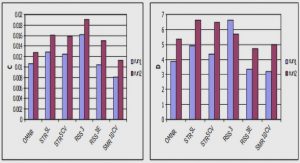Get Complete Project Material File(s) Now! »
INTRODUCTION AND BACKGROUND INFORMATION
Few countries would have travelled the social, economic and political distance South Africans have in the ten years of its democracy. The journey has, however, not been without problems. While the availability of solid public policy indicates the beginning of the process of delivery to all, it alone is insufficient if not supported by effective systems and processes for actual delivery. The biggest challenge lies in the government’s effectiveness and efficiency in reaching its goal. Several mechanisms put into place to improve the delivery of public services fall short and where they do not, no one is able to say with confidence what the level of success or failure is because, instruments to measure success or failure are not as accurate, have not been implemented or do not exist. Performance related and management decisions are taken, not on the basis of information available but mostly as a response to some crisis.
In the ten years since South African democracy came into being, much has been achieved, and a lot more could have been, especially in the area of policy implementation and improving performance. The so-called twin challenge of institutional transformation including integrating the former apartheid administrations and introducing policy (The Presidency, 2003:3) has resulted in levelling the political playing field. A shift from policy formulation towards implementation and efficiency faces the government University of Pretoria etd – Luthuli, T B (2007) now. A number of efforts such as the introduction of Multi-Purpose Community Centres (MPCC’s) and Anti-Corruption Strategies as well as legislation directed at achieving efficiency and effectiveness have been put
in place.
The problem of performance improvement was realised from the beginning of the new democratic era, and mechanisms to deal with it were put into place. The performance vision was codified through the enactment of the Constitution of the Republic of South Africa (1996), and various supportive policies and legislation (Msengana-Ndlela, 2004). The White Paper on Reconstruction and Development (RDP) (1994:s5.7), for example in its endeavour to liberate the true potential of the public service, visualised an introduction of a performance measurement system to increase productivity.
Enshrined in South Africa’s Constitution (Constitution, 1996:s195) is the determination to promote values directed at improving efficiency, effectiveness and economy. Accordingly, The White Paper on Transforming Public Service Delivery also known as Batho Pele (WPTPS) (1997:s1.1.2), criticised the manner in which public services are delivered. This White Paper, concerned with the improvement of service delivery, further introduces the service recipient into the service delivery and quality equation. The response to a need for a performance management system has so far come from the human resources perspective, through Public Service Regulations (1999) by requiring the introduction, in state departments, of performance management systems that link individuals to agreed performance outputs and levels. Realising the organisational performance gap, The Public Finance Management Act (PFMA) (1999) brought together all these performance improvement initiatives by insisting on adherence to the three e’s (efficiency, effectiveness and economy).
However, the organisational performance monitoring gap has remained despite this endeavour. Accountability requirements have also placed an obligation on government organisations to report on success or failure (Constitution of the Republic of South Africa, 1996:92(2), (3), 133 (2) and (3); Public Service Commission, 1999)) regularly (on an annual basis) on predetermined outputs (WPTPS, 1997). In reality, there is agreement with the public sector reform missionaries, for example, Osborne and Gaebler (1993:147) state that ‘if you do not measure results, you can’t tell success from failure and if you can’t recognise failure, you can’t correct it’. This is true in many respects and mitigates for a move towards measuring performance, something that South Africa has evaded in the past (Presidential Review Commission Report, 1997). Accountability becomes a fad if it is not accountability for delivery on the basis of policy requirements which is what government agencies are concerned with.
Policy needs to be reflected as a vision and a mission that the organisation has set for itself, this means that the organisational strategy, objectives and the resultant indicators need to reflect policy objectives and priorities. It is balancing the policy to the strategy that is sometimes a big challenge to technocrats.
CHAPTER ONE: INTRODUCTION AND BACKGROUND INFORMATION BACKGROUND TO THE STUDY
THE SOUTH AFRICAN PUBLIC SERVICE IN CONTEXT.
SIGNIFICANCE OF THE STUD
AIMS AND OBJECTIVES OF THE RESEARCH
PROBLEM STATEMEN
THE RESEARCH QUESTIONS.
STRUCTURE AND OUTLINE OF THE REPORT
CLARIFICATION OF KEY CONCEPTS.
BACKGROUND ARGUMENTS
CONCLUSION.
CHAPTER TWO: RESEARCH METHODOLOGY
INTRODUCTION
RATIONALE FOR CHOICE.
OBJECTIVITY AND THE TYPE OF RESEARCH
RESEARCH WITHIN HUMANITIES, ADMINISTRATION AND MANAGEMENT50
THE RESEARCH STRATEGY.
SIGNIFICANCE OF THE METHODOLOGY.
THE PROBLEM STATEMENT AND METHODOLOGY.
THE RESEARCH QUESTION
VALIDITY AND RELIABILITY TESTS.
SCOPE AND THE NATURE OF THE THESIS
LIMITATIONS OF THE STUDY
CONCLUSION
CHAPTER THREE: PERFORMANCE MEASUREMENT IN PERSPECTIVE
INTRODUCTION.
THE CHALLENGES OF THE SOUTH AFRICAN PUBLIC SERVICE
RATIONALE FOR A PERFORMANCE MEASUREMENT SYSTEM IN THE PUBLIC SERVICE
COMPARATIVE LITERATURE ON PUBLIC SECTOR EFFICIENCY AND EFFECTIVENESS
ACCOUNTABILITY.
PUBLIC MANAGEMENT,POLITICS AND ADMINISTRATIVE EFFICIENCY
PUBLIC MANAGEMENT AND ORGANISATIONAL THEORY.
THE THEORETICAL FOUNDATIONS OF POLICY IMPLEMENTATION
PRODUCTIVITY IN THE PUBLIC SECTOR
APPROACHES TO PERFORMANCE IMPROVEMENT
FROM POLICY TO STRATEGY: IMPLEMENTATION FOR SUCCESS
THE SOFTER SIDE OF PERFORMANC
THE MANAGEMENT OF CONFLICT
CONCLUSION
CHAPTER FOUR: POLICY IMPLEMENTATION AND PERFORMANCE MEASUREMENT
INTRODUCTION
PROBLEMS WITH POLICY IMPLEMENTATION IN SOUTH AFRICA.
SELECTED IMPLEMENTATION MODELS: AN ANALYSIS
THE ROLE OF CENTRAL AGENCIES IN GOVERNMENT POLICY IMPLEMENTATION
THE SOUTH AFRICAN PUBLIC POLICY ENVIRONMENT
INSTITUTIONALISING PARTICIPATION AND POLICY ANALYSIS IN SOUTH AFRICA
ACCOUNTABILITY FOR ENSURING SUCCESS
PRODUCTIVITY IMPROVEMENT AS A TOOL FOR POLICY IMPLEMENTATION
PLANNING AND FORECASTING FOR POLICY IMPLEMENTATION
COSTING POLICY BEFORE IMPLEMENTATION
RESULTS AND PERFORMANCE BASED BUDGETING APPROACHES
PERFORMANCE AGREEMENTS, ADMINISTRATIVE ACCOUNTABILITY AND AGENCY ARRANGEMENTS
CHAPTER FIVE: PERFORMANCE MEASUREMENT IN PUBLIC
ORGANISATIONS
CHAPTER SIX: CONCLUSION, RECOMMENDATIONS AND AREAS FOR
FURTHER RESEARCH





